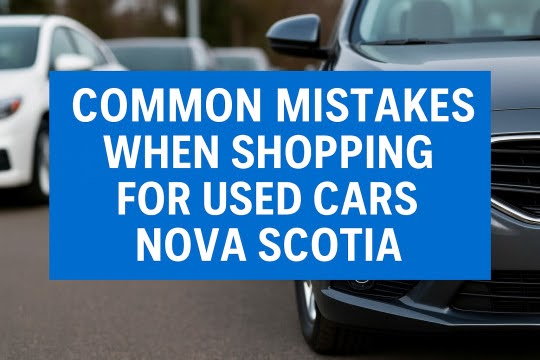Buying a used car in Nova Scotia can be a smart financial move,if done right. With rising prices for new vehicles and long dealership waitlists, more Canadians are turning to the pre-owned market. But without careful research and planning, it’s easy to fall into traps that cost more in the long run.
From skipped inspections to unclear financing, this guide breaks down the common mistakes when shopping for used cars Nova Scotia buyers need to avoid, and how working with a reputable dealership can protect your wallet and peace of mind.
1. Not Setting a Clear Budget (Including Hidden Costs)
Most buyers consider only the sticker price. But the total cost of ownership includes insurance, registration, taxes, financing interest, maintenance, and,especially in Nova Scotia,rustproofing or winter tires.
Set a total budget first. Then break it down into:
Purchase price
Financing (interest rate and term)
Insurance quotes
HST (15% in Nova Scotia)
Licensing and inspection fees
Having this full picture prevents surprises after signing.
2. Skipping the Pre-Purchase Inspection
Nova Scotia’s climate,snow, salt, and fluctuating temperatures,can accelerate wear on brakes, tires, suspension, and undercarriage components. Yet many buyers skip an inspection to “save time.”
This is risky.
Even cars with a clean CARFAX can hide problems. Always ask for or schedule:
A third-party mechanical inspection
Brake pad and tire tread checks
Rust and frame corrosion review
Diagnostic scan (for recent code clearing)
Dealers like Carlantic offer certified inspections included in their sales process,so buyers get transparency up front.
3. Ignoring Vehicle History Reports
A free test drive and a good vibe are not substitutes for proper documentation. Every used car purchase should come with a recent CARFAX or CarProof report.
These reports tell you:
Whether the car has been in accidents
If it was ever written off or rebuilt
Whether there’s outstanding lien or recall issues
Service history, where available
Dealers who avoid sharing this are waving a red flag.
4. Overlooking Financing Terms
Dealers often advertise low monthly payments,but fail to highlight high interest rates or long loan terms that cost you more overall.
Don’t be lured by the monthly payment alone. Ask:
What’s the total cost of the loan?
What’s the interest rate and APR?
Are there penalties for early payment?
Get pre-approved with your bank or credit union before visiting a dealer to compare terms.
5. Not Understanding Hidden Fees
It’s common for dealerships to add documentation fees, extended warranty costs, or other charges that inflate the final price. These aren’t always disclosed upfront.
Always ask for a line-item bill of sale before agreeing to purchase. A transparent dealer will walk you through each fee.
6. Rushing the Decision Without Comparing Options
Many buyers fall for pressure tactics or make a purchase after visiting just one location.
That’s one of the common mistakes when shopping for used cars Nova Scotia residents often regret. Shoppers often rush into buying used cars without checking financing terms, inspecting thoroughly, or understanding hidden fees. Carlantic helps you avoid these errors
with no-pressure sales, certified inspections, and honest pricing.
Take your time. Compare models, check competing listings, and test drive at least two vehicles before signing anything.
7. Not Checking for Winter Readiness
Nova Scotia’s winters can be brutal. If the used car doesn’t come with winter tires or heated features (seats, steering wheel, mirrors), you may face added costs later.
Ask:
Are winter tires included?
Is the undercarriage rustproofed?
Does the car have remote start, heated mirrors, etc.?
These are more than luxuries,they’re safety necessities in Atlantic Canada.
FAQs: Used Car Buying in Nova Scotia
Is it safe to buy a used car privately in Nova Scotia?
It can be, but private sales lack the inspections, warranties, and financing support that licensed dealerships like Carlantic provide. Extra due diligence is required when buying privately.
Should I trade in my old car or sell it myself?
Trading in is faster and reduces the taxable amount of your new purchase. Selling privately can bring in more money, but requires more effort.
What’s the minimum deposit I should make on a used car?
Dealers often require 10–20%. A larger deposit reduces your loan size and interest costs.
Can I return a used car after buying it in Nova Scotia?
Unlike some U.S. states, Nova Scotia doesn’t mandate a cooling-off period. Once the paperwork is signed, it’s final,another reason to choose a reputable dealer.
Conclusion: Smart Choices Lead to Lasting Satisfaction
Buying a used car should never feel rushed or unclear. Whether you’re a first-time buyer or upgrading your ride, avoiding these common mistakes when shopping for used cars Nova Scotia ensures a smoother experience and better long-term value.
Choose licensed dealers like Carlantic
that offer vehicle history reports, certified inspections, transparent pricing, and financing that works for you. With the right preparation, your next car can be a reliable investment,not an expensive lesson.




